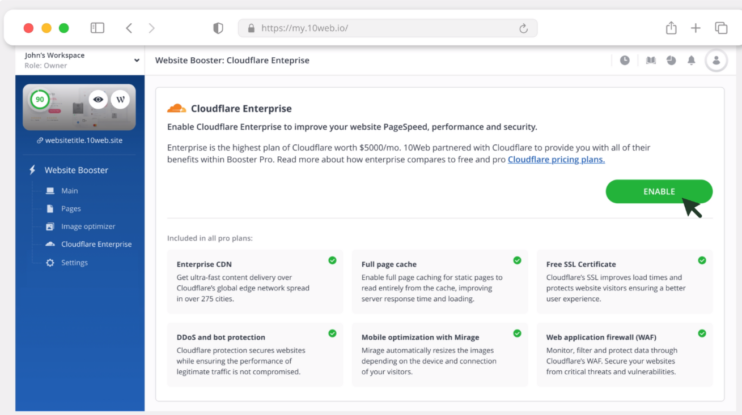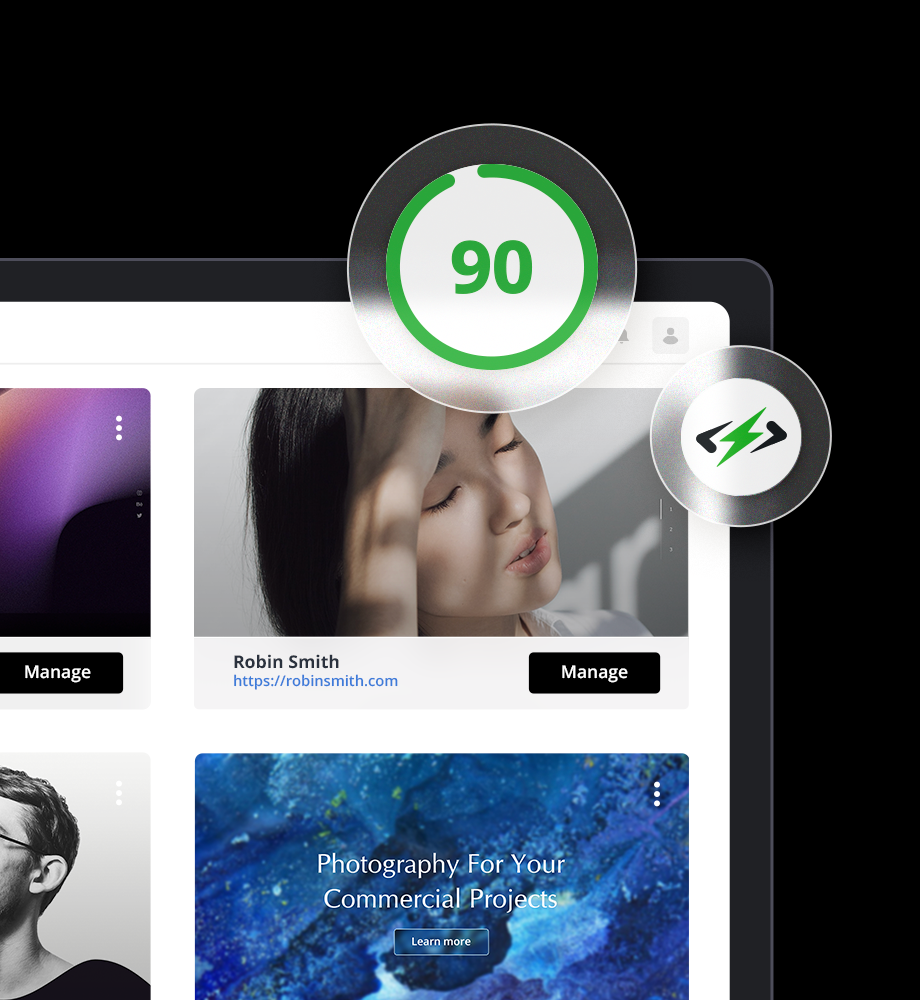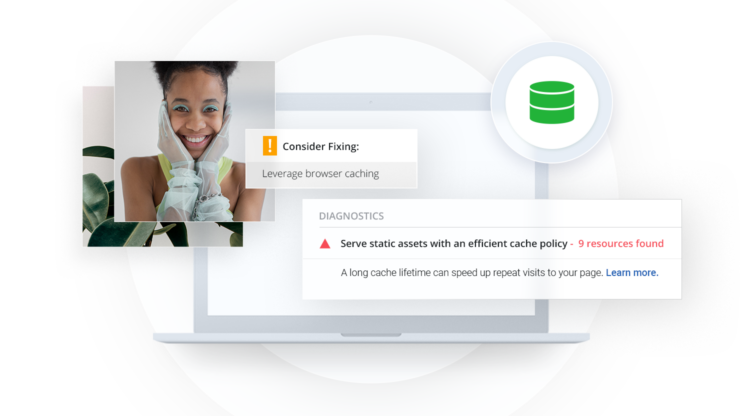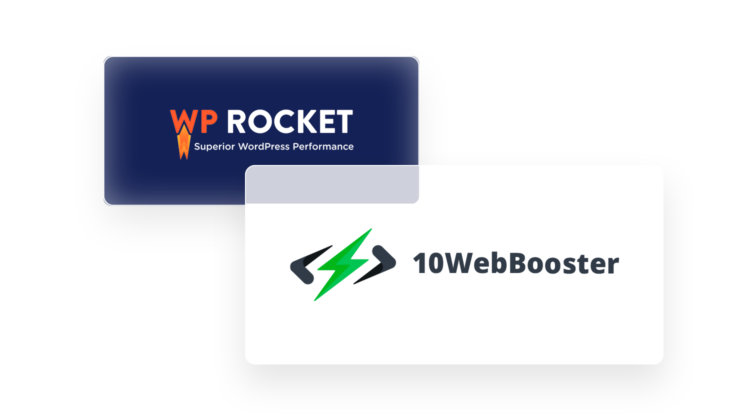Improving your page load times and site speed is key if you want users to spend more time on your WordPress website, build an audience, and get them to try some of your products. Back in 2010, the Google search team announced speed would be a ranking signal for desktop searches, and as of July 2018, this was extended to mobile searches as well. While the ultimate goal was improving user experience, faster load times can boost your site ranking on the Search Engine Results Page(SERP).
Content Deliver Networks (CDN) have become critical in building modern web applications. Over time CDNs have also become increasingly popular and important in improving performance, reliability, and the resilience of webpages to cyber attacks.
In this article, we’ll define a CDN and let you know how WordPress CDNs work, their advantages, and how to install one on your WordPress site. We will also outline some of the best CDN solutions available and how you can leverage them to improve load times. We will also give you expert tips on how 10Web can help you speed up your WordPress site.
What is a Content Delivery Network (CDN)?
A CDN is a network of geographically distributed proxy servers that work together to speed up content delivery to the end users. Also known as CDN Point of Presence (CDN PoPs), these servers are located at junction points of high-speed internet fiber cables in order to be able to serve web pages at the highest speed. Having users access content based on their geo-proximity to CDN servers takes the load off the origin server and significantly reduces latency.
How WordPress CDN Works
Using a CDN on your WordPress site is similar to using it on any other website. CDNs are strategically placed in front of the web server hosting your WordPress site. Through reverse proxy load balancing, they take off the load on your server by distributing traffic to cached pages across different PoPs. These PoPs represent different data centres that are geographically distributed around different regions of the world.
The main principle behind using a robust CDN infrastructure is geo-proximity which is often combined with caching to server data to the user by region in the most optimal time possible.
Typically, CDN servers cache static resources such as media, fonts, CSS, and JS files so that whenever a user requests these resources, they are served the cached versions. The cached resources are stored and served from a server close to users in a given region. But it is even more powerful when webpages are served from CDN. Such mode of operation is possible if CDN supports reverse proxy. Not only just cached, but also optimized webpages can be served through a CDN, making a website super fast.
For instance, when a user is accessing a Website hosted in San Francisco from Dubai UAE for the first time, all the requested static resources are requested from the main server and cached on a CDN server near them. On subsequent requests, these users are served with the cached copy from the closest Point of Presence. This reduces the distance these resources travel if the request were to be made to the host server in San Francisco again.
These resources have certain expiration periods (cache expiration), and whenever they expire, the same process of retrieval and update from the main (origin) server happens again. Also, resources can be updated manually (cache flush or reset), for example, if the original content is modified.
Do you need a CDN for WordPress?
If you want to improve your WordPress load times and the user experience, then a CDN is something you should consider. However, many other reasons may influence your decision. Here are some:
If your WordPress site has a global audience
Unless you’re using geolocation restrictions, also known as geoblocking, to prevent users from certain geographic locations from accessing your content, your website is likely to attract visitors from all over the world. To guarantee fast load times and a good user experience for visitors located far away from where your website is hosted, you’ll need to set up CDN Points of Presence that are closer to these users.
A CDN is still a good idea even when a fairly small number of visitors is outside the primary location where your website is hosted. You can access real-time statics of your WordPress site visitors using a WordPress plugin of your choice.
If your WordPress site has large media files
Big media files are one of the significant causes of slow load times on websites. Having a CDN in place will take the load off the main server where your website is hosted and instead serve these static resources from distributed CDN PoPs.
Unoptimized images are also the most common culprits of slow WordPress sites. A CDN for images will automatically resize, compress and optimize images allowing you to deliver graphics and images seamlessly. Faster delivery of images is key to creating a good user experience, especially on mobile devices.
If your WordPress site experiences traffic spikes
A sudden increase in the number of visitors to your website is good only if your website is prepared to handle such spikes. More website traffic means more conversion rates if you’re running a business. However, a sudden surge in the number of visitors can also break your website and cause a temporary outage.
By distributing requests across different servers through reverse proxying, CDN servers enable your website to handle seasonal or unexpected traffic. Besides reducing the load on your central server, a CDN can (depending on what type of content it serves) also help mitigate a DDoS attack and protect your production server. A CDN is, therefore, a good way to guarantee uptime and eliminate single points of failure.
We have discussed why you need a CDN for your WordPress site. Virtually any business can benefit from a CDN. However, some businesses can only function well if CDNs are in place.
- Social networks
- High-traffic e-commerce websites
- Services of online booking
- Online gaming platforms
- Live streaming platforms
Benefits of using a CDN on your WordPress site
Here are some of the benefits of using a CDN on your WordPress site:
1. Performance boost
Optimizing your WordPress load time is a great way to give users a good experience browsing your site. Happy users are likely to keep browsing your site and are more likely to try your products. On the other hand, if your page takes more than the recommended time to display content, users are likely to think that your page is broken. A good load time, ideally 0 to 4 seconds, correlates to high conversion rates, while a load time greater than that leads to higher bounce rates.
Google uses a handful of signals to measure site performance. Among the most recent addition to this list is the page experience signal that combines the Core Web Vitals (CWV) such as the Largest Contentful Paint, First Input Delay, and Cumulative Layout Shift. By caching status resources such as images, videos, CSS, and JS close to the users’ location, a CDN can help improve your core web initials scores.
Although page load time is affected by many factors, a CDN can boost performance and increase the chances of your site attaining a 90+ PageSpeed score.
Want to speed up your website instantly?
Get 90+ PageSpeed Score automatically with 10Web Booster ⚡
On any hosting!
Here is how a CDN can help your site get a good score on some core web vitals.
Reduces Time To First Byte (TTFB)
TTFB is a metric that measures the responsiveness of your web server to users’ requests. This metric is used in the lab and the field to measure the time between a request for a resource and when the server’s first byte of the resource is received.
A CDN significantly reduces the Time to First Byte on static resources including pages by caching resources across different edge locations. CDN servers also take a load off your web server, thus reducing the TTFB.
Improving Largest Contentful Paint (LCP)
LCP is a user-centric metric that measures the time it takes for the page’s main content to be loaded. To optimize LCP, you need to optimize the optimal subpart times that constitute this metric. One of the LCP subparts is the resource load time, which contributes approximately 40% of the total score of LCP.
Improving Time to Interactive (TTI)
There are a number of ways to reduce resource TTI. For example, apart from optimizing the size of the resources, particularly render blocking JS and CSS files, you can also reduce the distance these resources have to travel. These can be done using CDN Points of Presence.
Improving First Input Delay (FID)
FID measures the time before the user can interact with your page. Using a CDN, you can deliver assets such as Javascript close to the user allowing the user to engage with your site as quickly as possible.
2. Low Bandwidth costs
In website hosting, bandwidth refers to the amount of data transferred between a site and its users, usually measured in megabits per second. Managing your site’s bandwidth is key if you wish to scale your website without spiraling running costs. Your site’s bandwidth can differ depending on the number of resources(images, videos, text), your users’ location and the traffic to your site.
CDN servers help manage your bandwidth by caching static resources and serving them to users making subsequent requests. By caching content in a CDN server, you significantly reduce the traffic to the origin server and hence lower the bandwidth.
Web hosting companies charge you according to your site bandwidth, i.e. the amount of data transfer between the host server and your users. Typically a CDN can handle 60 to 80 % of your bandwidth, leaving the host server to the web page. Therefore delegating the role of serving static assets to a CDN will certainly reduce your bandwidth costs.
Hotlinking can also be one of the reasons why your site may accrue very high bandwidth costs.
Hotlinking happens when another site links resources, usually images, hosted on your site and displays them on their site. Whenever users of the other person’s website access those images, they are requested from your host server. Your hosting provider will charge you for the extra bandwidth. To keep your images safe, a CDN allows you to restrict HTTP referrers and prevent other sites from linking to your assets without permission.
A CDN can also sustain your site during seasonal or unexpected traffic hikes, saving you from an unexpected bandwidth cost. Although you may also need to pay for CDN services, the costs of running without them far exceed CDN fees.
3. High Availability and Scalability
Availability refers to the ability of your website to consistently remain functional and provide resources over a certain period regardless of the prevailing circumstance, i.e. a power outage. Scalability, in this case, refers to the ability of your website to meet the increasing demand for resources without breaking.
Many actions need to be taken to guarantee the availability and scalability of any website. Having a CDN in place can also considerably boost the availability and scalability of your WordPress site. Offloading and caching static resources of your website to CDN PoPs allows your website to serve a significantly higher number of users using the existing infrastructure.
If some of the servers in the CDN have an outage, If some of the servers in the CDN have an outage, a good CDN can leverage its available servers (in the same region or others) to distribute the content, thus bypassing the servers that are down.
4. SEO Advantages
Good page load times generally improve the user experience while browsing, boosting your website ranking in the Google search index. Increasing your WordPress site ranking is key to increasing your site’s traffic and potentially increasing your conversion rates. Besides increasing visibility, a good ranking also increases your website’s credibility.
Speed has been one of the ranking signals that Google has used to rank webpages since 2010 and 2018 for mobile traffic. Page load times correlate to the user’s experience on any website. Although the weight of page speed as a ranking signal is undefined, it is clear that Google prioritizes sites that load faster.
A CDN can also help your images rank well on Google’s Search Engine Results Page (SERP). By caching your images on a CDN, they are indexed quickly, and your users can access them faster; hence Google is likely to crawl them often. As a result, your images will rank at the top of Google’s image search. Image clicks can contribute to a significant amount of traffic to your site.
5. Additional Security
As the number of active users and devices on the internet grows by the day, so does the number of malicious attacks that disrupt websites and organizations. A security breach can lead to the loss of confidential data, downtime, and financial loss. Your brand reputation could also suffer.
Although a CDN is mostly attributed to improving performance, it can also help keep your website safe. Some CDNs, such as Cloudflare, also protect against attacks such as Denial of Service attack(DoS) and Distributed Denial of Service (DDoS) attacks. Unexplainable high traffic from a single IP range is likely to be a DoS attack and can easily break your website if protection is not in place. DDoS attacks utilizing a large number of IPs are even more dangerous. Due to their sheer scale, CDNs can detect and absorb such traffic allowing your site to stay online.
The Token authentication mechanism provided by CDNs allows you to protect your images and videos from unauthorized use and hotlinking. Hotlinking can lead to very high bandwidth costs. CDN token authentication ensures that requests to use resources on your site only come from a credible and trusted site. You can also allow or deny requests from a specific referrer.
Through a CDN, you can also set up application firewalls to block SYN/ACK, DNS amplification and attacks on the application layer of the network. You can also put your site behind a proxy using a CDN.
6. Improved User Experience
Page speed directly influences user experience in so many ways. A faster website will likely impress users and make them spend more time on your site. On the other hand, users are likely to perceive your page to be broken if it takes more than 5 seconds to load. CDNs allow you to cache content on the network edge, reducing the latency caused when resources travel from the origin server to the users.
CDNs also improve uptime and scalability, ensuring that your site can serve users optimally even when there is a surge in traffic. Therefore CDNs can help you or your business preserver user experience instead of renting additional servers during peak times.
CDNs provide real-time insights and analytics, and you can leverage them to improve user experience on your website.
How to Improve Load Times With a CDN
The primary goal of CDNs is to deliver content efficiently to the users. Delivering content with little or no latency improves your site’s load times. Here is how you can leverage a CDNs to improve load time:
- Reduce the physical distance between your clients and the requested resources.
- A CDN can also help bolster the performance of your server-side infrastructure by adding solid-state drives and load-balancing.
- You can also use a CDN to compress static resources and optimize images and videos to improve load times.
Best CDN Solutions for WordPress
There are many CDN service providers in the market. While the benefits of using a CDN on your website may seem straightforward, the wide range of available WordPress CDN services can be overwhelming. In this section, we have highlighted some of the top CDN solutions for your WordPress site.
Cloudflare CDN
Cloudflare CDN is the most popular CDN service for WordPress sites. With a vast global network of over 275 data centers and direct connection to nearly every cloud and service provider, the Cloudflare network enables you to reach over 95% of the world’s population in less than 100ms.
Cloudflare is one of the few CDN solutions with a free plan that includes DDoS protection. The free plan is perfect for small businesses and personal WordPress sites. Cloudflare Zero trust is built with security in mind, enabling seamless identity and software-defined security.
Without sacrificing performance or struggling with legacy hardware, you can access built-in, software-defined Zero Trust services, DDoS mitigation, firewalls, and traffic acceleration.
Remember that with Cloudflare enterprise integration into 10Web booster, purchasing the 10Web Booster gets you the Cloudflare CDN that would otherwise cost $25 per month. Setting up Cloudflare on your WordPress site with 10Web is as easy as installing the plugin and creating a free account. Remember also to apply the one-click configuration to apply the recommended settings. Apart from 10Web’s advanced optimization, enabling Cloudflare CDN within the 10Web Booster reduces latency and load times for static and dynamic content and cuts down bandwidth costs by up to 60%.
Learn how you can benefit from the 10Web and Cloudflare integration here.
Key features
- Minimal configuration to set it up on your WordPress site.
- Advanced user interface.
- Built-in DDoS protection.
- Cache optimization options like Page Rules.
- Cloudflare provides you with SSL capabilities if you lack one. It is also compatible with your existing SSL with no further configuration.
- Web application Firewall(WAF) with an intuitive dashboard where you can set rules with simple clicks.
- Improved performance on mobile pages through image optimization and lazy loading.
- 24/7 support through email, chat, and phone with a median response time.
Cloudflare has a free plan that suits personal or hobby projects that are not business-critical. To access premium and advanced features, you can opt for the paid plans with $25/month. However with 10Web you can get Cloudflare with $8/month per site or even less. In the last section we will explain how 10Web CDN integration works.
Want to speed up your website instantly?
Get 90+ PageSpeed Score automatically with 10Web Booster ⚡
On any hosting!
Akamai
Akamai is a global leader in Content Delivery Network (CDN) providers for media and software delivery and network security solutions. Akamai offers CDN solutions that enable you to create extraordinary digital experiences for your customers by flawlessly and securely delivering content at scale.
With a global edge server density of more than 240 000, Akamai has access to over 85% of the global internet users in their network. Akamai has been around since the early days of the internet and provides a suite of leading security, computing, and delivery solutions to global companies.
Some of the world’s reputable, innovative brands, such as Apple, Facebook, and BMW, use and trust Akamai.
Other Key features
- Cloud Wrapper allows you to save on costs and improve origin offload with a private cache footprint.
- Data stream to give you an inside look into CDN performance with log data at scale.
- Media analytics to analyze video delivery performance, audience behavior, and viewer engagement.
- Global traffic management ( GTM) for DNS-based load balancing.
- Image and video delivery optimization using the image and video manager.
- Cloud test that allows you to stress test your website with real-time load testing.
Akamai offers a free tier for client-side edge security and most of their products. However Akamai is more an enterprise solution and is best fitting if your WordPress website is a high-traffic or enterprise site. You can contact their support team for details on pricing.
Amazon Cloudfront
Amazon Cloudfront is a Content Delivery Network (CDN) that helps you distribute static and dynamic content. With over 400+ globally distributed Points of Presence(PoP), built-in compression, edge compute capabilities, and intelligent routing, Cloudfront enables you to deliver content with low latency to viewers across the globe.
You can optimize and accelerate dynamic content delivery and APIs by leveraging the AWS global network infrastructure supporting Web sockets and edge termination. You can also defend your website against DDoS attacks using the AWS shield at no extra cost and improve security through encryption and access controls.
To integrate AWS CloudFront into WordPress, you must create a free AWS account.
You can integrate CloudFront into your WordPress site using the Amazon AWS CDN plugin. Alternatively, you can offload your media and assets to an existing S3 bucket and serve them through Amazon CloudFront.
Other Key features
- Programmable and secure edge computing capabilities through CloudFront functions.
- Real-time metrics also logging to Amazon CloudWatch.
- Full features APIs and DevOps tools.
- Backend architecture redundancy and native failover capabilities to increase availability.
- High-level deployment safety through continuous deployments.
CloudFront offers personalized pricing plans such as the CloudFront security bundle, pay-as-you-go, and custom pricing.
Fastly CDN
Fastly is a high-rated CDN that offers different services, such as DDoS mitigation, and a modern CDN that allows you to deliver faster, personalized, engaging experiences to your users globally. With access to over 95 Nodes worldwide, Fastly enables you to deliver content and applications faster via mobile and web.
Fastly caches static resources and allows you to perform full-page caching, improving your site’s TTFB. Besides caching more content, Fastly allows you to keep and retrieve it over longer periods. Fastly allows you to cache and purge your WordPress content almost as soon as it is updated on your origin server.
Using Dynamic Site acceleration Fastly speeds up requests and responses between your WordPress host and cache node in all Points of Presence so that content is served faster.
Fastly also leverages advanced algorithms to ensure that your content is routed via optimal routes.
You can install the Fastly WordPress plugin from the plugging directory. Before testing your connection, you’ll also need to sign up for Fastly, generate an API token, and save it under the WordPress blog admin panel.
Key Features
- Real-time logs streamed from the edge to give you near-instant visibility into your traffic trends, security threats, and performance.
- Support for Agile DevOps and easy integration into your existing workflows.
- Ability to change content easily and roll back the changes almost instantly. (hassle-free version control)
- Built-in security through DDoS, TLS, and WAT offerings that give you a safe environment to create and build on WordPress.
- Ability to cache more at the edge since you can also purge quickly using the configurable CDN.
Fastly has a free standard plan available as soon as you signup for Fastly. The Essential plan that includes 3TB global delivery per month and 30MM Image Optimizer images per month is perfect for small and midsize businesses looking for a trusted solutions provider. You can also access premium features using the Professional and Enterprise plans at a fee. You can submit a form for more details on pricing and a demo.
StackPath
StackPath is one of the best CDNs on the market today. The StackPath CDN gives you access to comprehensive built-in capabilities allowing you to optimize your assets and deliver and protect your content. StackPath also provides unmatched customization tools and features that let you customize your delivery options.
With 50+ strategically placed edge locations, anyCast network, redundant Tier-1 connections, and exceptional cache depth, you can deliver your content to the end-users with exceptionally low latency.
StackPaths CDN service is perfectly suited for WordPress, giving you access to real-time monitoring, image optimization, and advanced security features.
Using the DN Enabler WordPress plugin, you can link your assets to StackPath CDN by rewriting the Base_URL variable to the CDN domain. Further configuration details are available on the StackPaths support page.
Key Features
- Built-in CDN asset optimization tools, including GZip compression and large file segmentation.
- Easy to use CDN rules engine that allows you to set EdgeRules on content delivery.
- Origin shield for more origin server protection and optimization, enabling you to reduce origin server burden and bandwidth costs.
- Real-time analytics and full-time reporting include bandwidth usage, requests, cache hit ratio, request hit ratio, and HTTP status codes.
- Private SSL certificates.
- Image optimization for low latency when delivering images.
StackPath’s basic plan costs $25/month and gives you a CDN bandwidth of 1TB/month, CDN requests, CDN EdgeRules, CDN edge location, and SSL certificate and support. You’ll need to pay for additional bandwidth and other features at rates listed on their home page.
KeyCDN
KeyCDN is an excellent CDN service for WordPress sites. It is a simple, fast, and reliable CDN service offering high-performance content delivery, allowing you to deliver an exceptional user experience. KeyCDN gives you full control over your WordPress assets, a RESTful API and a powerful, intuitive management dashboard.
KeyCDN provides a leading encryption service, allowing you to safely deliver content to users using the nearest points of presence. With a focus on performance, KeyCDN includes a highly optimized IP Anycast, geolocation routing capabilities, and a customized TCP stack.
You can integrate KeyCDN into your WordPress site using the CDN Enabler plugin. The process is fairly straightforward.
- Create a Pull Zone.
- Log in to your WordPress admin dashboard.
- Go to the CDN Enabler settings.
- Update the CDN Hostname setting with your Zone Alias (e.g. cdn.example.com) or Zone URL (e.g. example-hexid.kxcdn.com).
- Click Save Changes and Validate Configuration.
- If applicable, clear your WordPress cache.
Key Features
- Image optimization and transformation in real-time.
- Global network with over 40 data centers.
- Zone management allows you to edit easily and add or remove zones.
- Instantly purge individual or entire content in seconds.
- Detailed reports, statistics, and traffic details to help you optimize the user experience.
- Easy setup and configuration.
KeyCDN pricing differs based on regions. However, they charge a minimum fee of $4/month. Pricing also includes unlimited HTTP and HTTPS requests to help keep costs low and affordable from the beginning.
How To Install a CDN in WordPress
Every CDN service has unique installation and integration guidelines. However, by installing 10Web Pro, you are guaranteed complete front-end and back-end optimization and access to Cloudflare enterprise CDN and other enterprise features for unbeatable security and performance. By upgrading to 10Web Booster pro for only $8 per site, you not only get access to 10Web’s advanced optimization but also access to the world’s most robust enterprise CDN infrastructure that would otherwise cost $25 per site.
Cloudflare Enterprise provides a market-leading CDN network for websites connected to the 10Web dashboard and hosted anywhere. When you enable the Cloudflare CDN, we provide you with DNS records which you add to where your DNS management is. Once the records have been resolved, your website automatically takes advantage of Cloudflare’s world-class features.
Follow the steps below to install 10Web Booster Plugin on your website.
- Log in to your WordPress administrator panel.
- Select the Plugins page from the toolbar menu, and click Add New.
- Search for 10Web Booster in the right-top search bar if you want to download the Free version, or click the Upload Plugin button > “Choose file” (“Browse”) and select the 10Web Booster zip file.
Once you’ve installed 10Web Booster and upgraded to Pro, you can easily enable Cloudflare enterprise from your 10Web Booster intuitive dashboard. You do not need to switch the advanced Cloudflare interface and back.

You can do this from the dashboard by going to Cloudflare Enterprise and clicking ‘Enable’. After that, you’ll be prompted to double-check your original server IP, point your domain, and configure DNS records as instructed. After your website is verified, Cloudflare Enterprise will show an ‘Active’ status in your dashboard’s ‘Overview’ tab.
Note that the 10Web Booster is integrated with the Cloudflare Enterprise package, not the free CDN. This will give your WordPress site a significant performance boost and unparalleled speed for your users around the globe. Access to the full benefits of Cloudflare’s Enterprise tier guarantees seamless website performance and reduced latency and load time.
You can learn more about the benefits of 10Web’s Booster and Cloudflare integration here.
Alternatively, if you wish to install a different CDN service, check each CDN documentation or use third-party plugins for integrations.
How 10Web Can Help Speed Up Your WordPress Site?
10Web combines Google’s Cloud hosting infrastructure with a collection of intelligent tools and services to create a powerful hosting solution that enables your website to run at peak performance.
10Web Booster is a free WordPress plugin that lets you optimize both the front and back end of your site and get it to the top 1% of the fastest-loading sites. 10Web Booster is the most effective WordPress website optimizer in the market and will help you increase your PageSpeed score and pass all Core Web Vitals. Regardless of your hosting partner, you can access free frontend optimization of homepages + 5 inner pages, a 90 + PageSpeed score, and 24/7 support using the free plan.
With 10Web Booster Pro, you get frontend optimization for websites hosted on any hosting. Apart from that optimization, 10Web booster Pro has the Cloudflare CDN integrated within it, giving you access to all the CDN’s features right within your 10Web interface.
Regardless of the visitor’s location or hosting solution, enabling Cloudflare Enterprise CDN within 10Web Booster pro provides a game-changing experience for any WordPress website. Reduce latency and load times for static and dynamic content and cut bandwidth costs by up to 60%.
Here are the benefits of enabling the Cloudflare CDN integrated within 10WebBooster:
- Ultra-fast static and dynamic content delivery across Cloudflare’s global network.
- Full page caching for static pages to read entirely from the cache, improving server response time and loading.
- Website, application, and network protection from malicious attacks
- Web application Firewall to monitor, filter, and protect your data.
- Automated optimization of images based on device and network connection types for each visitor.
Here is how our 10Web Speed booster can help you speed up your WordPress site:
- Page and file caching to help you improve load time.
- CSS, HTML, and JS minification and compression to lessen network traffic and increase file execution time and the overall frontend speed.
- Image, iframe, and video lazy loading to reduce requests on load and optimize page speed.
- Image optimization and compression. Compressed images are delivered through Cloudflare CDN.
- 10Web booster programmatically interacts with your website and gathers all CSS rules before generating CSS critical for correctly rendering your page on load.
- 10Web locates and separates critical and non-critical Javascript files and automatically delays non-essential scripts until user interaction is necessary without breaking your page.
- Font swap – 10Web Booster uses font-display: swap, which allows the browser to initially load a default font, and once the custom font loads, it swaps the default font with your custom font seamlessly. The process enhances page speed and avoids Flash of Unstyled Text (FOUT) or Flash of Invisible Text (FOIT) issues.
Regardless of your business niche, a faster website can have great returns and be the distinguishing factor from your competition. However, it is also not ideal to spend countless hours manually optimizing your site to provide the best user experience.
With 10Web Booster, you can automatically optimize your site to have excellent load time, seamless performance, and high-quality visuals without engaging in arduous manual processes. You can try our free 10Web booster plan for excellent optimization or upgrade to our 10Web Booster with Cloudflare Enterprise for unrivaled performance.
Want to speed up your website instantly?
Get 90+ PageSpeed Score automatically with 10Web Booster ⚡
On any hosting!
Speed up your website instantly
Speed up your website instantly
-
Automatically get 90+ PageSpeed score
-
Experience full website caching
-
Pass Core Web Vitals with ease





 Automatically get 90+ PageSpeed score
Automatically get 90+ PageSpeed score 










Hi Tigran,
Thanks for letting us know about WordPress CDNs work and their advantages, Over time CDNs have become increasingly popular and important in improving performance, reliability, and the resilience of webpages to cyber attacks.
Hi Olivia,
I couldn’t agree more. Thank you for your feedback!